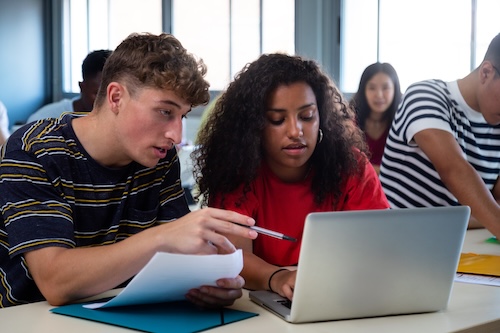Key points:
As a National Board-Certified Teacher, I love incorporating media literacy, environmental literacy, and civic engagement into my teaching. I want my students to think critically about how things interconnect, and I am always searching for new and engaging ways to help them lead with curiosity.
In a recent lesson, I had my students explore the circular economy and biomimicry. For their summative assessment, they used the engineering design process to create products to address local or global problems utilizing nanoscience and nanoparticles. They were challenged to think about the issue (climate change) from a unique perspective (nanotechnology).
To make this project happen, I relied on two free resources connecting the dots between the classroom and the wider world:
Resource 1: Concept of a circular economy
The first resource I used was a pre-made studio teaching about the concept of a circular economy. With lessons plans and video lesson bundles from the Environmental Education Initiative, my students learned with this resource that participating in a circular economy is an innovative way to have a positive impact on the planet. They saw how students in Charlotte, North Carolina are participating in a circular economy by reusing, recycling, and repurposing old bike parts.
My students enjoyed creating connections and were able to grasp how their actions connect to the wider world. This resource was instrumental in helping students identify problems around them. I love the plug-and-play nature of the resources; they serve as excellent introductory hooks and points for further discussion. Additionally, the topics are timely and relevant to students’ lives, making the learning experience more engaging.
Resource 2: Sustainable futures
The second resource I used to assist students with their design process was from the Sustainable Futures program with Trane Technologies. There are so many resources, but my students especially loved the resource on biomimicry. This resource showcases how nature can inspire innovative design solutions. From bats’ echolocation being the basis for radar and sonar devices to geckos’ sticky feet inspiring the design for adhesives, we are constantly motivated by the world around us to create products that help people.
Having a resource with ready-to-go-lessons like this makes understanding high-level topics like biomimicry-based design easy, providing students opportunities to engage with content in a brand-new way.
This resource served as a great introduction and jumping-off point for students in their design challenge. It also provided a scaffold for students to refer to when sharing their ideas. Like the first resource, I appreciate how it is ready-made and can easily enhance classroom learning experiences.
Insider tips:
Having these materials ready at your fingertips is only the first step, and there are so many good resources out there. Sometimes, though, it can be hard to know how to get started. Here are my three insider tips for facilitating the use of these resources:
- Tip 1: The Discovery Education resources are great if you are looking for vetted content on just about any topic. Whatever you’re teaching, there is a good chance you’ll find some kind of video or activity that can be adapted or used in your classroom to complement your lessons.
- Tip 2: When I am looking for resources that are aligned with real-world examples and exposure to industry careers, finding trusted information that covers a wide range of pathways is top of mind. Once I see what my students are really interested in, I look to help them make career connections by intentionally noting job titles and industries.
- Tip 3: Getting your students to engage with the lesson makes all the difference in their academic success. That’s why I love project-based learning–the students get a “something” out of the lesson that they made themselves. Project-based learning experiences put students in charge of their own learning and provide opportunities to elevate their own student voice.
Integrating resources like these into your teaching can make a significant difference in student engagement and learning outcomes. The world is incredibly unique and there are many ways to creatively draw connections between seemingly unconnected topics and industries. This better prepares students to think critically in all aspects and pushes them to live curiously.


